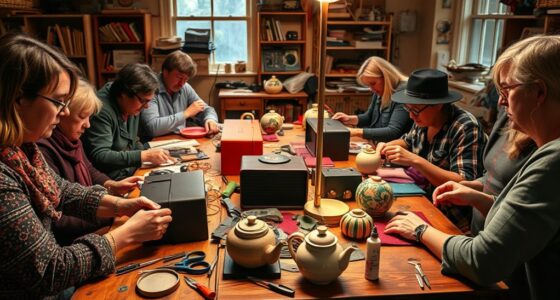Swap and share tool libraries let you borrow a wide range of tools for DIY projects instead of buying them. This saves you money, reduces clutter, and boosts community sustainability. You gain access to high-quality equipment, enjoy skill sharing, and avoid storage issues. Responsible borrowing guarantees tools stay in great shape for everyone. If you’re curious about how these libraries work or want tips on getting involved, there’s more to discover just ahead.
Key Takeaways
- Swap & Share Tool Libraries offer community access to tools, reducing the need to buy expensive equipment for DIY projects.
- Borrowing tools saves money and storage space, making DIY projects more affordable and manageable.
- These libraries promote sustainability by sharing resources and extending tool lifespans, minimizing waste.
- Membership and responsible borrowing ensure tools are maintained, safe, and available for ongoing community use.
- Online directories and local groups help find nearby tool libraries, supporting cost-effective, eco-friendly DIY efforts.
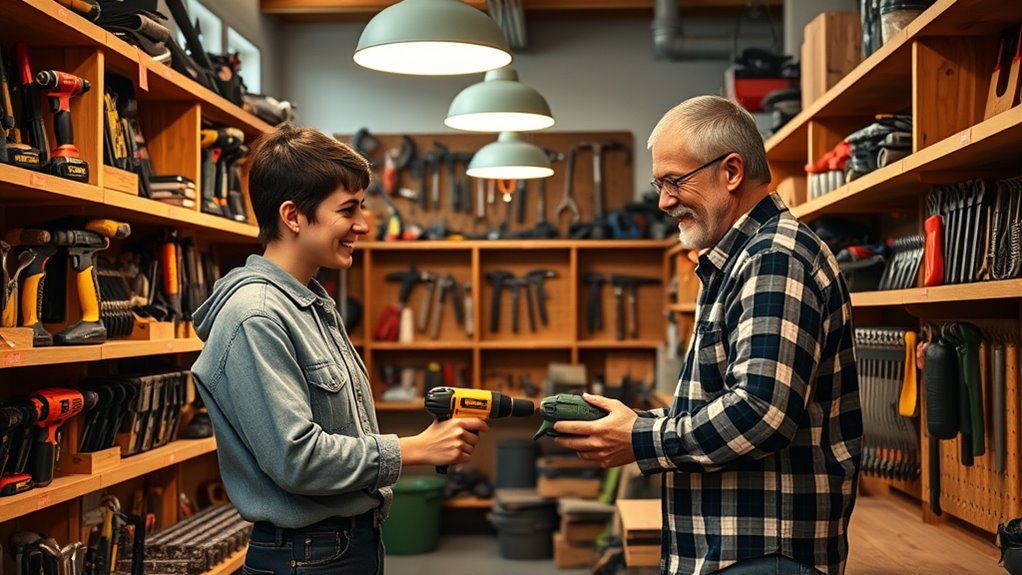
Have you ever needed a specific tool for a project but didn’t want to buy it? Swap & Share tool libraries are community-driven spaces where you can borrow tools instead of purchasing them. These libraries operate like a library for books, but instead of borrowing novels, you borrow drills, saws, gardening gear, and more. Members bring in tools they no longer need and exchange them for others. This system promotes sharing, reduces clutter, and saves you money. It’s perfect if you only need a tool temporarily or for a one-time project. By joining a Swap & Share tool library, you gain access to a wide variety of equipment without the hefty price tag, making DIY projects more affordable and eco-friendly. In addition, many of these libraries incorporate cost savings techniques to maximize affordability for members. Cultivating creative practice can also help you come up with innovative ways to utilize shared tools effectively and efficiently. Embracing community sharing benefits can further enhance your experience with these programs. Engaging with community sharing initiatives can also provide opportunities for networking and social connections, enriching your overall DIY experience.
How Do These Community Tool Hubs Work?
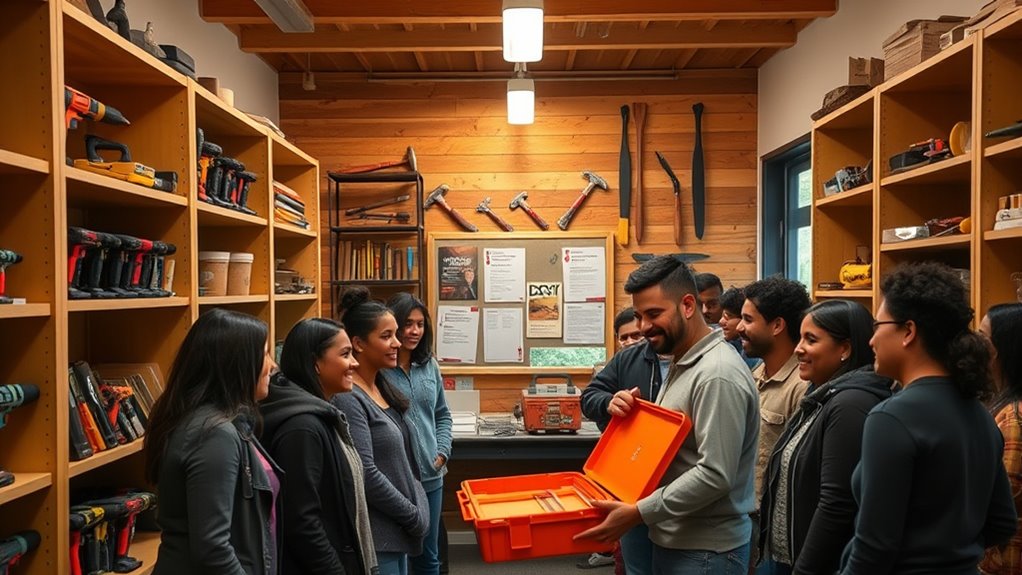
You can join a tool library with a simple membership, giving you access to a wide range of tools. When you borrow an item, just check it out through the system and return it when you’re done. It’s a straightforward process designed to keep tools available and in good shape for everyone. To create a welcoming environment, some libraries even feature decorative touches that make the space feel more inviting and community-focused. Additionally, many tool libraries implement privacy policies to protect user information and ensure a secure borrowing experience. Incorporating sound healing science principles, some libraries use calming sounds or music to enhance the environment and make visitors feel more relaxed during their visits. Proper storage and handling of tools, including expiration of stored items, help maintain their safety and functionality for all users.
Membership and Access
Community tool hubs typically operate on a membership system that grants access to shared tools and resources. When you join, you usually sign up online or in person, providing basic information and sometimes paying a small fee. Membership often involves agreeing to rules that promote responsible use and safety. Once you’re a member, you can access the tools during designated hours, often through a key or access code. Some hubs require you to complete a brief orientation or training session to ensure you know how to use the equipment properly. Membership is designed to create a trusted community, allowing you to borrow tools when needed without the hassle of ownership. It’s a convenient, cost-effective way to get your DIY projects done while sharing resources with others. Additionally, many community tool hubs are supported by platforms like TikTok, which help promote awareness and encourage community engagement. These hubs often implement safety protocols to protect members and ensure proper tool handling, aligning with the emphasis on quality ingredients and formulations found in trusted brands. Understanding small mistakes, big impact can help prevent accidents and ensure tools are used safely and effectively. Moreover, incorporating safe operation practices can extend the lifespan of tools and improve overall safety during DIY projects.
Borrowing and Returning Process
When borrowing tools from a community hub, members typically check out equipment during designated hours using a key, access code, or sign-in system. You scan your membership card or enter a code, then select your tools. After use, returning items is straightforward: return them during open hours or follow drop-off procedures. To help visualize, here’s a quick overview:
| Step | Action | Details |
|---|---|---|
| Check Out | Use key/code to access tools | During open hours |
| Borrowing | Select needed tools | Confirm checkout |
| Usage | Use tools on your project | Handle with care |
| Returning | Return tools to designated area | Follow drop-off instructions |
| Check In | Confirm return & clean tools | Ensure tools are ready for next user |
Additionally, maintaining the tools by following proper maintenance guidelines ensures their longevity and optimal performance. Proper tool handling is essential to prevent damage and ensure safety during your projects. Moreover, familiarizing yourself with the community tool policies can help streamline the borrowing process and promote shared responsibility. Being aware of your privacy and cookie preferences can also help improve your overall experience while managing your privacy expectations. Recognizing the importance of organized inventory systems can further facilitate an efficient borrowing experience and help track tool availability.
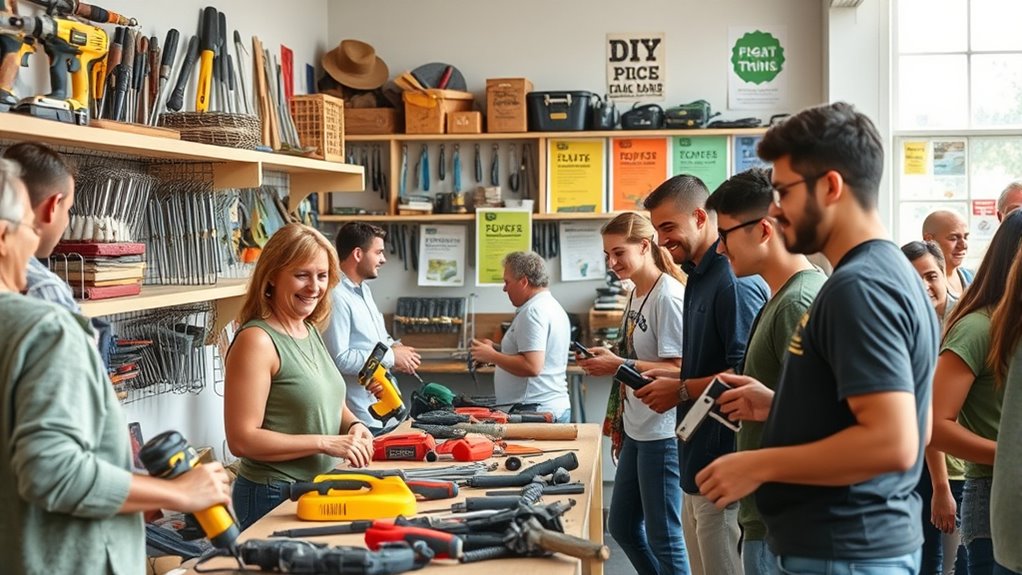
Using swap and share tool libraries saves you money by giving you access to tools without purchasing them. You also have the chance to exchange skills and knowledge with other community members. These benefits make tool libraries a smart and social way to handle your projects. Additionally, many tools available in these libraries include airless paint sprayers, which are highly efficient for painting projects. Some libraries also offer pimple patches, which can help with quick skin blemish treatments during busy DIY days. Incorporating versatile skincare products like hydrocolloid patches can further enhance your skin care routine while working on home improvement projects.
Cost-Effective Access
One of the biggest advantages of swap and share tool libraries is how they save you money. Instead of buying expensive tools for a one-time project, you can borrow what you need at a fraction of the cost. This eliminates the burden of purchasing rarely used equipment, freeing up your budget for other supplies or improvements. Plus, you avoid storage issues since you don’t have to keep tools long-term. Many libraries have flexible borrowing periods, making it easy to plan your projects without rushing or extra charges. By sharing resources, you get access to high-quality tools without the hefty retail price. Overall, swap and share libraries make DIY projects more affordable and accessible, allowing you to complete jobs without breaking the bank.
Community Skill Sharing
By participating in swap and share tool libraries, communities foster skill sharing and collaboration among residents. When you borrow tools, you often exchange tips, techniques, and advice with others who share your interests. This creates a sense of connection and encourages learning from neighbors. As you share your skills, you help build a stronger, more resourceful community. People become more confident tackling projects, knowing they can rely on others’ expertise. Additionally, this exchange promotes sustainability by reducing the need for everyone to own every tool individually. You gain access to specialized equipment you might not afford or use often, while helping others do the same. Overall, community skill sharing through tool libraries nurtures a collaborative environment that benefits everyone involved.
How to Find Local Tool Libraries Near You
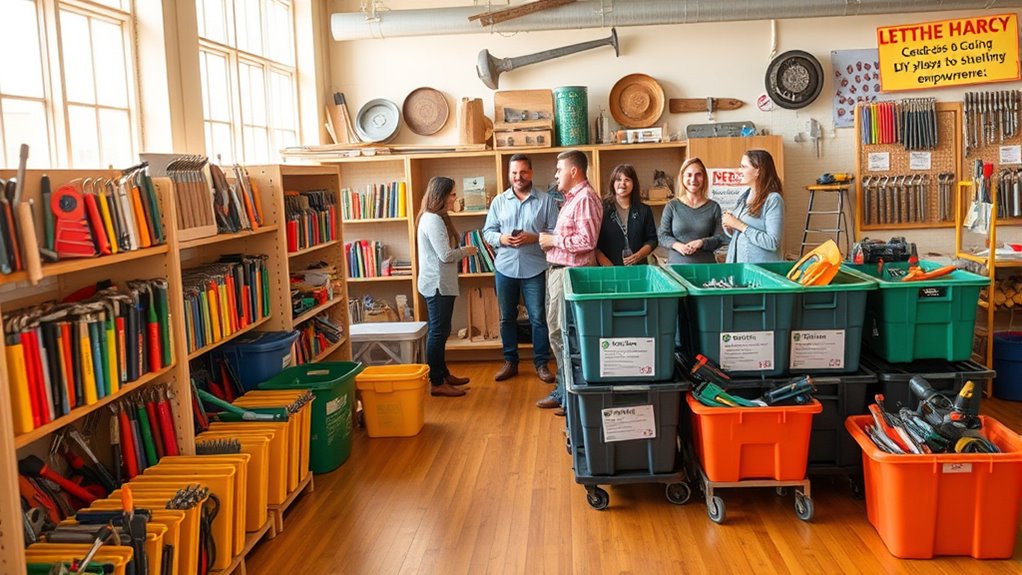
Finding local tool libraries is easier than you might think. Start by checking online directories or searching “tool library near me.” Many cities have dedicated websites or community portals listing nearby options. Social media groups or local forums can also provide recommendations. To simplify your search, here’s a quick reference:
| Method | What to Expect |
|---|---|
| Google Search | Instant results with addresses |
| Community Centers | Local resource info |
| City Government Websites | Official listings and programs |
| Social Media Groups | Community recommendations |
| Word of Mouth | Personal suggestions from neighbors |
With these methods, you’ll find a tool library close by, ready to help you save on DIY supplies.
Tips for Borrowing and Returning Tools Responsibly

To guarantee you maintain a good relationship with your local tool library, it’s important to borrow and return tools responsibly. Always check the condition of tools before borrowing, and handle them carefully to avoid damage. Keep track of loan periods and return tools on time to prevent penalties or inconvenience for others. Clean tools after use, removing dirt or debris, so they’re ready for the next borrower. If you notice any issues or damage, report it promptly to the library staff. Respect the borrowing limits and only take what you need. When returning tools, do so in a timely manner, and ensure they’re clean and in good condition. Responsible borrowing helps keep the library’s tools available and in great shape for everyone.
Popular Tools Available in Community Libraries
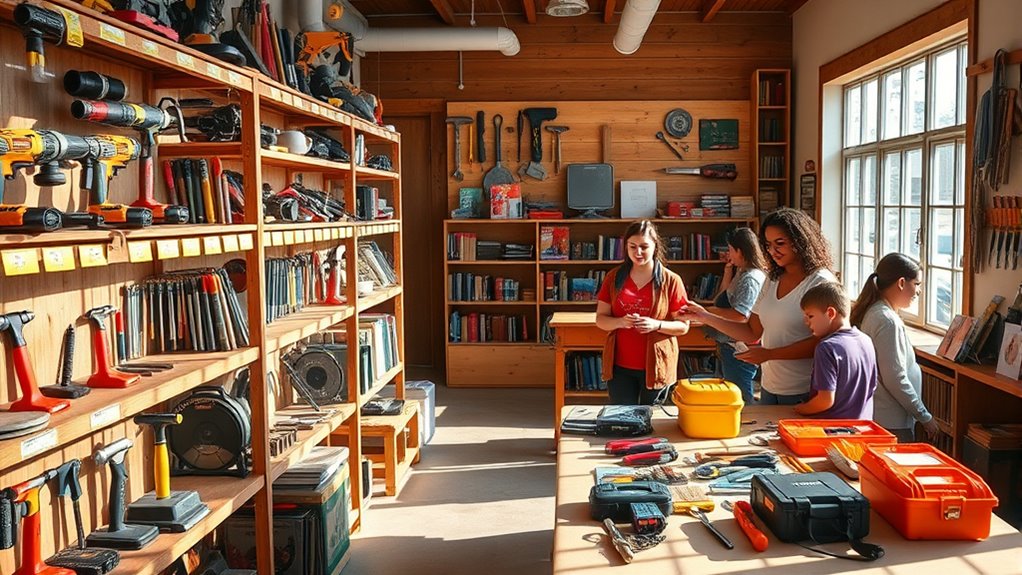
Community libraries often stock a wide range of popular tools that can help you tackle various projects around your home or yard. You’ll find essentials like drills, saws, and lawn equipment ready for borrowing. These tools cover common DIY needs, making it easier to complete tasks without purchasing expensive gear.
| Power Tools | Hand Tools |
|---|---|
| Cordless drills | Hammers |
| Circular saws | Screwdrivers |
| Jigsaws | Pliers |
| Leaf blowers | Wrenches |
This selection ensures you have access to the most needed items, whether you’re building furniture or maintaining your garden. With these popular tools readily available, you can confidently handle a variety of projects, saving money and reducing clutter in your garage.
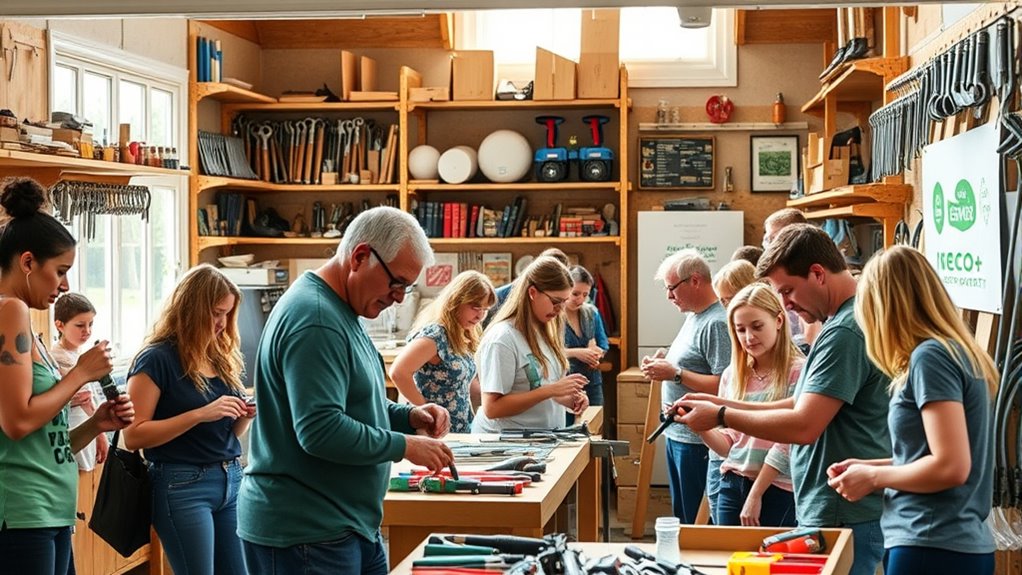
Swap and share models directly reduce waste by maximizing the use of existing tools rather than encouraging constant purchasing. When you borrow or trade tools, you prevent items from ending up in landfills, lowering overall waste. This approach minimizes the demand for new products, which often require significant resources and energy to produce. By sharing, you extend the lifespan of tools, reducing the need for manufacturing new ones. Additionally, these models foster a community-focused mindset, promoting responsible consumption. They help conserve natural resources like water, minerals, and timber, which are heavily used in manufacturing. Overall, swap and share systems support a more sustainable lifestyle by decreasing environmental impact, encouraging reuse, and reducing the carbon footprint associated with manufacturing and transportation.
Getting Involved and Supporting Your Local Library
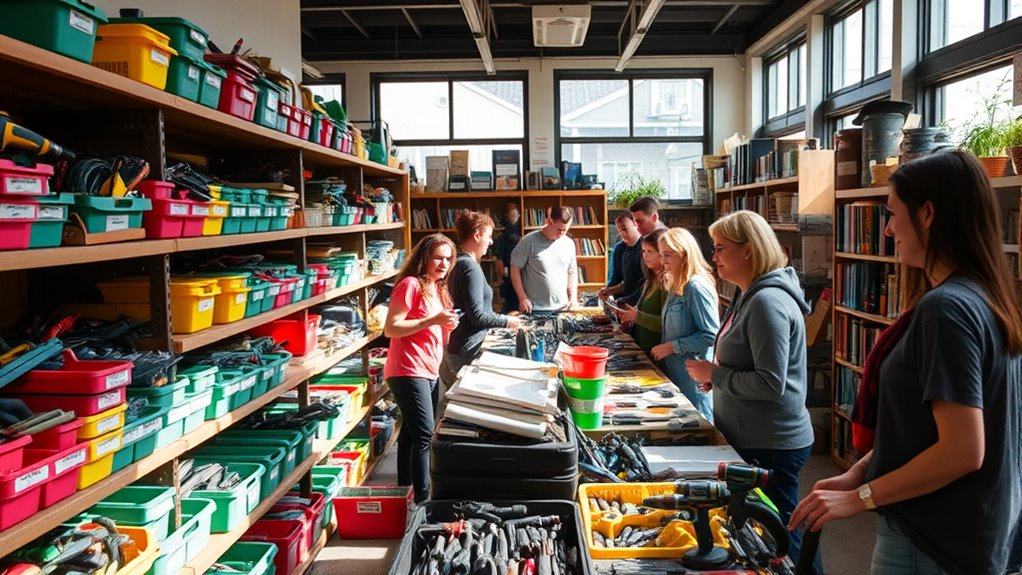
Ever wondered how you can make a real impact on your local library’s success? Supporting your library doesn’t have to be complicated. You can start by:
- Volunteering your time for events or maintenance. Your help keeps the library vibrant and functional.
- Donating tools, books, or supplies that can benefit the community. Your contributions expand resources.
- Spreading the word about your library through social media or community groups. Increased awareness brings more visitors and support.
Getting involved not only strengthens the library but also builds a sense of community. Your participation ensures the library remains a valuable resource for everyone. Supporting local libraries is a simple yet powerful way to promote DIY initiatives and shared resources.
Future Trends in DIY and Shared Tools
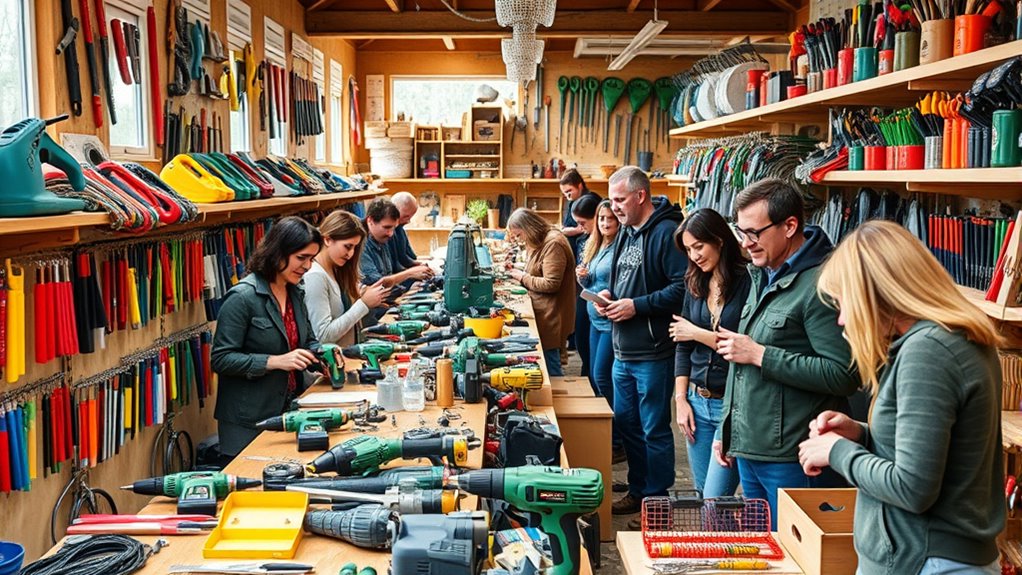
Have you noticed how DIY and shared tool initiatives are evolving with technology? Smart apps and online platforms make borrowing and lending tools easier than ever. Expect more integrated systems that track tool usage, notify you when items are due, and connect you with nearby neighbors or communities. In the future, automation and IoT devices could enable tools to self-report maintenance needs or even be shared via blockchain for secure, transparent exchanges. Virtual reality might also play a role, offering tutorials and project planning in immersive environments. As technology advances, these innovations will make sharing more seamless, accessible, and efficient. You’ll find it easier to complete projects, reduce waste, and foster community connections through smarter, tech-enabled tools.
Frequently Asked Questions
Are There Membership Fees for Joining a Tool Library?
You might wonder if there are membership fees when joining a tool library. Typically, many tool libraries do charge a small annual or monthly fee to cover maintenance and administrative costs. However, some offer free memberships or sliding-scale fees based on income. It’s best to check with your local library, as policies vary. Joining usually involves a simple registration process, and the benefits of access to a wide range of tools often outweigh the costs.
How Do I Volunteer to Help Run the Library?
You’re interested in volunteering to help run the library. To do this, start by reaching out to the library’s coordinator or visit their website for volunteer opportunities. Express your interest and mention any skills or experience you have. Many libraries welcome enthusiastic volunteers to assist with organizing tools, managing checkouts, or promoting the library. Your involvement can help keep the library running smoothly and benefit your community.
What Safety Guidelines Should I Follow When Using Borrowed Tools?
Imagine gripping a power drill, your hands steady and confident. To stay safe, always wear protective gear like goggles and gloves, ensuring sparks or debris don’t cause injury. Check the tools for damage before use, and follow the manufacturer’s instructions closely. Keep your workspace tidy, and never rush. If something feels off, stop and seek guidance. Your safety is key to enjoying a successful DIY project.
Can I Donate Tools to the Community Library?
You can definitely donate tools to the community library. It’s a generous way to support local DIY projects and make sure others have access to useful equipment. Before donating, check the library’s guidelines to confirm they accept tools and verify your items are in good condition. Clean and repair any damaged tools to help them last longer and be safe for others to use. Your contributions can make a big difference for your community.
Are Tool Libraries Available in Rural Areas or Only Cities?
Wondering whether tool libraries pop up in rural regions or stick to city streets? You’ll find that many tool libraries are indeed in urban areas, but some rural communities are catching on too. These resourceful repositories reach beyond city boundaries, offering outdoor tools and equipment for rural residents. With a little research, you’ll discover local lending libraries that support your DIY projects, whether in bustling neighborhoods or quiet countryside.
Conclusion
By embracing swap and share tool libraries, you’re joining a movement that’s as timeless as a medieval craftsman’s guild. Not only do you save money and reduce waste, but you also connect with your community and promote sustainability. So, don’t wait for a knight in shining armor—visit your local tool library today. Together, you can build a more resourceful, eco-friendly future, all while channeling a bit of the old-world ingenuity that’s stood the test of time.





